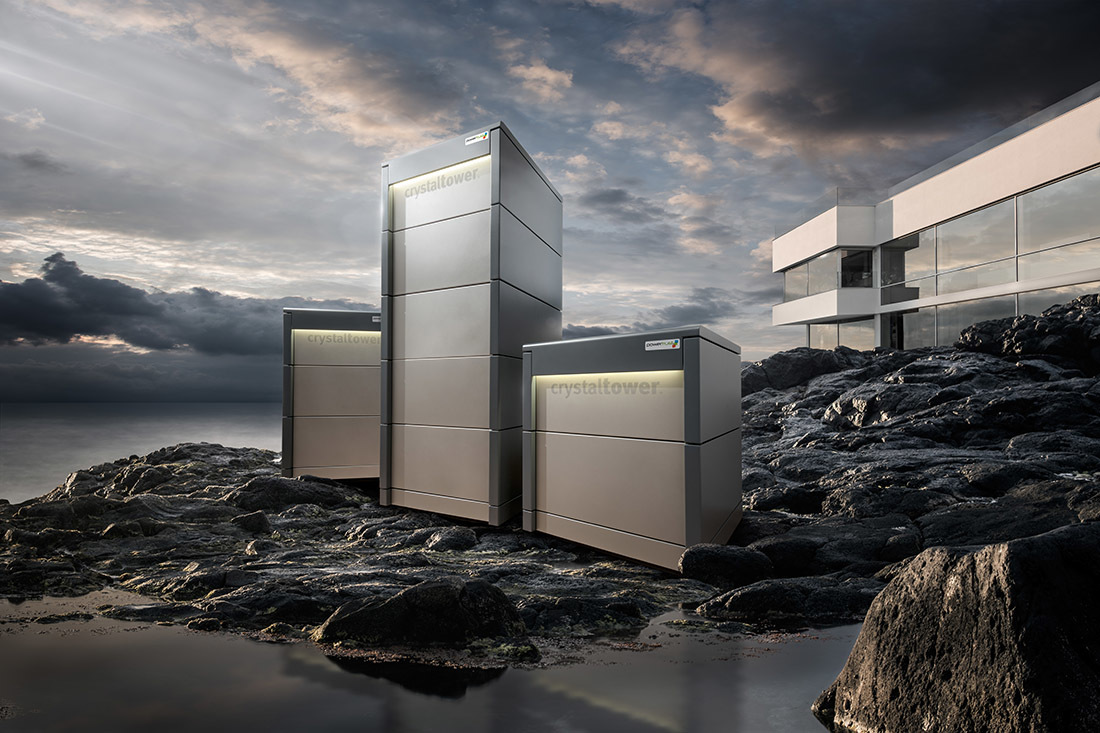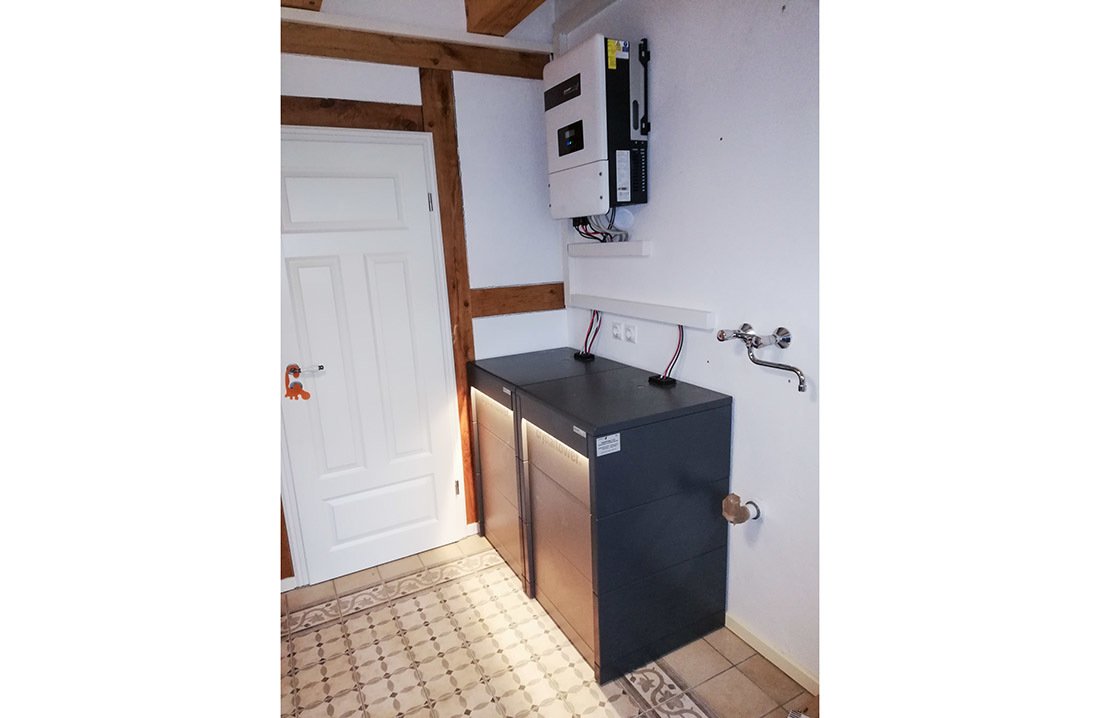Combating climate change with electricity storage from Bremen
Success storiesGerman-made batteries store the energy you generate

Storage batteries are an increasingly popular way of making energy generated by PV systems available around the clock. That is good for the environment and helps to keep costs down. Storage battery manufacturer Powertrust is looking to tried and trusted technology and giving it a new lease of life. Battery innovation made in Bremen.
Bremen’s Hockey Club is a major player – the women’s team is in Germany’s national league, and the club, which celebrated its centenary in 2013, has over 800 members. But the club is not only a big hitter in the league, it also leads the field when it comes to being green. Thanks to a PV system and storage batteries, the club is able to cover almost all of its energy needs.
Storage batteries and a PV system offer independence
The 100 KW PV system on the roof of the clubhouse has been installed to power the floodlights, among other things. But there is a problem: floodlights are needed when it is dark, not when the sun is shining. The club consumes little energy during the daytime. “Naturally, we wanted to use the power from our PV system as much as possible. As most of the games take place at dusk or when it’s dark, we had to find a way of storing the electricity,” says managing director Martin Schultze. The club found the solution around 8 kilometres away at Powertrust, a storage battery manufacturer based in Bremen. The company installed three state-of-the-art storage batteries with a total capacity of 65 kilowatt-hours for the club. What is unusual is that the batteries use lead-based technology. “Sustainability was a deciding factor for us on this project, and we can achieve that with the Powertrust batteries,” Schultze adds.
Storage batteries for industrial, agricultural and residential use
Founded just under five years ago, Powertrust is a relatively young company. It has taken an old technology and given it a new lease of life in the form of lead crystal batteries. The company uses these to manufacture electricity storage units that can be deployed almost anywhere to store volatile – i.e. not permanently available – energy, for example from PV systems, and provide it around the clock.
There are other areas besides renewable energy supply where the batteries come into their own. One industrial use, for example, is covering peak loads, which helps to keep electricity costs down. “There is also an economic dimension to consider in addition to being environmentally responsible and combating climate change. By combining storage batteries with photovoltaics, the annual rate of return over 20 years can be increased to up to 8 per cent. Investing in a PV system not only helps to protect the environment but also enhances the company’s image. These systems are much more than just a tax-efficient capital investment project,” says managing director Mike Heger.

The storage batteries from Bremen rely on lead crystal rather than lithium-ion technology
Hailing from Swabia, Heger is a perfectionist with a strong sense of environmental responsibility. His solutions are well thought out and technically flawless. He puts in a lot of effort, and is happy to follow the road less travelled. His use of lead crystal technology is the perfect example of this. It is not a technology that is widely used for storage, but he is a firm believer in it. “Lead is up to 99 per cent recyclable. Producing it causes fewer emissions and obtaining the raw material doesn’t destroy the landscape, as is currently the case with lithium extraction,” he says, listing some of the benefits. For Heger, sustainability starts with producing and ends with recycling the batteries. The storage units are designed to take almost any type of storage battery, and thanks to their open interfaces they can be used over a long period of time, even if battery technology improves in the future.
Not as sexy as lithium-ion batteries, but safer, more sustainable and more economical
Heger is keen to counter lead’s image as an outdated energy technology. Many people will immediately think of car batteries, but lead crystal technology is entirely different. Home electricity storage using lithium-ion batteries, for example those made by Tesla, is getting a lot of publicity. This technology is considered hip and advanced thanks to its association with the image of the car manufacturer from Silicon Valley.
Lead batteries are low-cost and offer more benefits
Heger prefers to let the facts speak for themselves. The list of benefits is long, and he is happy to name them. “Lithium-ion cells are reactive at very high temperatures, and are generally very temperature-sensitive, so they need to be cooled or heated, depending on where they are located. And that uses energy. Long-lasting, high discharge levels can usually only be achieved with high capacities,” says Heger.
Lead crystal batteries are considerably less sensitive, but they do weigh more than lithium-ion batteries, making them completely unattractive for electric cars, for example. Weight is less of an issue in buildings. Energy-intensive industries and businesses will be particularly interested in the figure for charge/discharge power. Lead crystal batteries provide high charge/discharge power relative to capacity, so they can step in if several larger energy consumers are switched on at the same time. In this scenario, lithium-ion systems can rapidly run down and need to fall back on conventional power. “If you have the hairdryer running at home and switch on the kettle, the load can exceed the typical discharge power of a lithium-ion battery,” Heger explains.

Storage batteries made in Bremen
This new ‘old’ technology is the result of many years of developing the battery and energy management system. The company now has seven employees working on improving it further, and plans to launch another technology on the market soon. It will feature lithium-iron cells in stainless steel casings, designed to combine the benefits of lithium-ion batteries with the safety of lead technology.
It will also offer a very high power density. “We want to deliver good work, be reliable and have satisfied customers. Quality, sustainability and the fight against climate change are what motivates us, not growth. As a team, we want to develop the best possible solution from a technological, environmental and financial perspective. A shift to carbon neutrality is absolutely possible, and we intend to be at the forefront of this change. With wind, solar power and storage,” says Heger of his company’s strategy.
Bremen is green in so many ways
Powertrust shares a building with service provider Adler Solar – a partnership that benefits both companies. “We complement each other perfectly. There is a lot of passing trade. Anyone who has a PV system will also be interested in battery storage”, says Heger.
Both Adler Solar and Powertrust believe there is great potential for renewable energies in Bremen. “There is plenty of room for PV systems on the roofs of buildings, so there is no need to use up any space on the ground. Combining these with wind power, district heating and battery storage provides a way for Bremen to become greener in terms of energy. Solar power is already the cheapest way of generating electricity, so if you store it for use when the sun has gone down, there is potential to save countless tonnes of CO2,” says Gerhard Cunze, managing director of Adler Solar.
Success Stories
Medium-Sized Companies in Bremen Showcasing the Full Range of the Local Economy
Medium-sized companies form the backbone of Bremen’s economy. They create jobs and produce goods that are in demand worldwide. Here is a selection of ten businesses that illustrate the diversity of Bremen’s economic landscape.
Learn moreMeasure, Test, Inspect – 11 Examples of Precision Engineering from Bremen
Not many people could name a manufacturer of metrology and testing equipment, but without their products we would not have space probes, aircraft or medical equipment. And Bremen is home to a whole host of these specialist companies.
Learn more8 Bremen Companies involved in Mass Spectrometry
If you want to get down to the smallest building blocks of our world, you need mass spectrometers. And there are few places in the world where there is such a high concentration of specialists and manufacturing companies and suppliers in this sector as in Bremen.
Learn more
